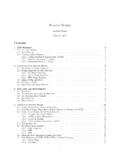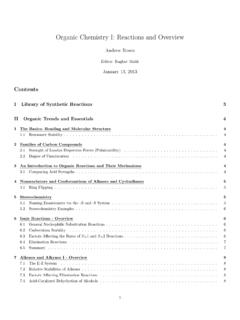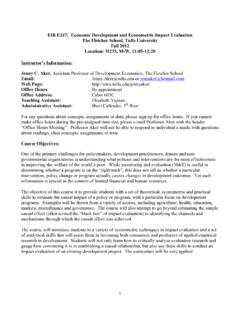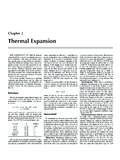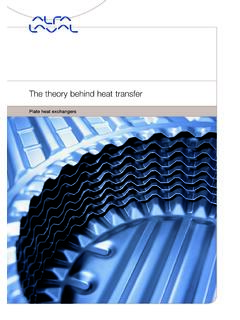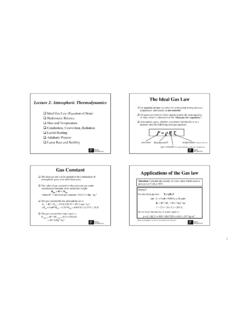Transcription of Heat and Mass Transfer - Tufts University
1 heat AND mass Transfer Based on CHEM_ENG 422 at Northwestern University TABLE OF CONTENTS 1 Introduction to heat Transfer and mass Transfer .. 4 heat Flows and heat Transfer Coefficients .. 4 heat Flow .. 4 Average heat Flux density .. 4 Local heat Flux density .. 4 Dimensions .. 5 The Differential Equations of Balance .. 5 mass Transfer Equation .. 6 Deriving the Diffusion Equation .. 6 Divergence of Flux density .. 7 mass Fraction Equations .. 7 heat Transfer Equation .. 8 2 Canonical Problems in heat and mass Transfer .. 11 Shell Energy Balance .. 11 Definition .. 11 Common Boundary Conditions .. 11 heat Conduction through a Cylinder with a Source .. 11 The Lumped Capacitance Method .. 12 One-Dimensional Slab.
2 14 Composite Materials .. 14 Concept of Thermal Resistance .. 14 Thermal Resistances in Series .. 15 Thermal Resistances in Parallel .. 16 Thermal Resistances with Convection .. 16 Rectangular Fin .. 17 Cylindrical Rod .. 19 Large Internal Resistance .. 20 Semi-Infinite Slab .. 20 Mathematical Solution .. 20 Estimating the heat Transfer Coefficient .. 22 Ratios of Thermal Conductivity and Thermal Diffusivity .. 22 Transient heat Conduction .. 23 Negligible Internal Resistance .. 23 Significant Internal Resistance .. 23 Infinite Cylinder Paradox .. 24 Order of Magnitude Analysis .. 25 Quasi Steady State Hypothesis .. 25 One-Dimensional Slab with Sinusoidal Boundary Temperature .. 25 Dissolution of Sphere into Fluid.
3 26 Diffusion with Irreversible Reaction .. 27 Dissolution of Sphere with Irreversible Reaction .. 27 Boundary Layer Theory .. 28 Overview .. 28 heat Transfer to a Free-Surface in Flow .. 28 Flow over a Plate .. 29 Green s Function Solution .. 31 Heated Sphere in Flow .. 32 3 Appendix: Vector Calculus .. 34 Coordinate Systems .. 34 Cartesian Coordinate System .. 34 Cylindrical Coordinate System .. 34 Spherical Coordinate System .. 35 Surface Differentials .. 35 Volume Differentials .. 35 Operators .. 36 Gradient .. 36 Divergence .. 36 Curl .. 36 Laplacian .. 37 Memorization Shortcuts .. 37 Common Vector Calculus Identities .. 37 Surface Integration .. 38 The Surface 38 Divergence 38 1 INTRODUCTION TO heat Transfer AND mass Transfer heat FLOWS AND heat Transfer COEFFICIENTS heat FLOW A typical problem in heat Transfer is the following: consider a body A that exchanges heat with another body, of infinite medium, B.
4 This can be broken down into either a steady problem or a transient problem. In the steady case, we have (for example) = constant, = constant, and we must find the total heat flow rate, , between A and B. In the transient case, we have (for example) = constant, = | =0= 0, and we must find as a function of time, . In most cases (exceptions: free convection due to density differences and radiation heat Transfer ), the heat flow rate is proportional to the temperature difference. In other words, from B to A we have . Note this means that heat Transfer , unlike fluid mechanics, is often a linear problem. It is convenient to define a total, integral heat Transfer coefficient such that ( ). For linear problems, will be independent of and.
5 Also, depends on physical properties of the bodies, their shapes, the fluid flow, and so on. AVERAGE heat FLUX density It is often very useful to consider an average area-based heat Transfer coefficient, , and an average heat flux density , , instead. In this case, we have ( ), where . With this definition, we can say that = . LOCAL heat FLUX density In general, the heat flux will differ from point to point. It is therefore more accurate to use a local heat flux density , , and a local area heat Transfer coefficient (LAHTC), . In this case, we have ( ), where . In other words, = and = . DIMENSIONS Note the following dimensions for the variables we have defined thus far: [ ]=[J][s], [ ]=[J][m2][s], [ ]=[J][s][K], [ ]=[J][m2][s][K].
6 THE DIFFERENTIAL EQUATIONS OF BALANCE We now wish to derive the very general differential equations of balance that can be used to describe the balance of an arbitrary scalar field, denoted [..], such that there is a conservation of said scalar ( it cannot be created or destroyed). We must first define a few terms. The density , , of [..] is given by [ ]=[..][m3]. We will also define a flux density , , given by [ ]=[..][m2][ ]. If we define a unit normal , we can then say that is the amount of [..] crossing, per unit a time, a surface element of unit area with unit normal in the direction of . We will also define the rate of formation, , of [..] per unit volume as [ ]=[..][m3][s]. We can then, logically, state that the balance of [.]
7 ] is given (in words) by (total rate of accumulation of [..] in volume )=(total rate of inflow of [..] crossing the surface )+(total rate of production of [..] produced in ). This is written mathematically as = + . Applying the divergence theorem = div( ) + . We can combine all the integrands together as ( +div( ) ) =0. Since this must be true over any volume and for any set of integral bounds, the integrand itself must equal zero such that +div( )= . This is the general equation governing all transport phenomena. In words, it is ( density )+div(flux density )=(rate of production). In the case where [..] is mass , is the typical density , = and =0 (if there is no reaction). Then we arrive at the conservation of mass +div( )=0.
8 For incompressible fluids, is constant such that div( )=0. If instead [..] is charge, is charge density , is current density , and =0. This leads to the conservation of charge equation. Additionally, if [..] is solute in a dilute solution, is concentration (often instead denoted ) and = + , where (lowercase) is the diffusive flux. mass Transfer EQUATION DERIVING THE DIFFUSION EQUATION With the previous development, we can say that for diffusion of a solute in dilute solution, we arrive at +div( + )= . This equation can be rearranged to the following form: +div( )= div( )+ . Using the vector calculus rules in Section , we can rewrite the above expression as + grad( )+ div( )= div( )+ . So far, this analysis has assumed nothing other than a dilute solution.
9 However, now we shall assume that the fluid is incompressible (this is true for most liquids, as well as gases moving at velocities much less than the speed of sound). This implies that div( )=0 such that + grad( )= div( )+ . We now employ Fick s law, which is an empirical relation given by = grad( ), where is the diffusivity, which depends on solute, solvent, and temperature. In the case of a constant diffusivity, div( )= div( grad( ))= div(grad( ))= 2( ). Plugging this in, + grad( )= 2( )+ . Note again that this only applies for dilute solution, incompressible fluid, and constant diffusivity. If you have no flow at all and no chemical reaction, the equation simplifies greatly to = 2 , which is appropriately called the diffusion equation in applied mathematics.
10 For steady (time-independent) situations, 2 =0, which is Laplace s equation. DIVERGENCE OF FLUX density It is also worth noting that if we start with the original mass Transfer equation at the beginning of this section and only make the assumption of steady-state conditions, we arrive at div( )= , which is the steady diffusion equation with chemical reaction. An analogous equation can be written in heat Transfer for the steady heat conduction equation, given by div( )= , where is the rate of production of heat (instead of mass ). These two equations have particular value since they do not rely on Fick s or Fourier s laws and the assumptions that underlie them. However, they more difficult to solve in practice. mass FRACTION EQUATIONS We shall now return to the equation of balance of solute without chemical reaction but with flow: + grad( )= 2c.


